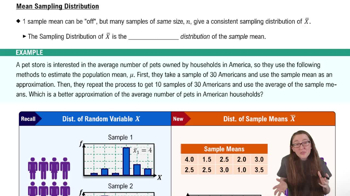Unusual Events In Exercise 19, would it be unusual for a household to have no HD televisions? Explain your reasoning.
Table of contents
- 1. Intro to Stats and Collecting Data1h 14m
- 2. Describing Data with Tables and Graphs1h 55m
- 3. Describing Data Numerically2h 5m
- 4. Probability2h 16m
- 5. Binomial Distribution & Discrete Random Variables3h 6m
- 6. Normal Distribution and Continuous Random Variables2h 11m
- 7. Sampling Distributions & Confidence Intervals: Mean3h 23m
- Sampling Distribution of the Sample Mean and Central Limit Theorem19m
- Distribution of Sample Mean - Excel23m
- Introduction to Confidence Intervals15m
- Confidence Intervals for Population Mean1h 18m
- Determining the Minimum Sample Size Required12m
- Finding Probabilities and T Critical Values - Excel28m
- Confidence Intervals for Population Means - Excel25m
- 8. Sampling Distributions & Confidence Intervals: Proportion1h 25m
- 9. Hypothesis Testing for One Sample3h 57m
- 10. Hypothesis Testing for Two Samples4h 50m
- Two Proportions1h 13m
- Two Proportions Hypothesis Test - Excel28m
- Two Means - Unknown, Unequal Variance1h 3m
- Two Means - Unknown Variances Hypothesis Test - Excel12m
- Two Means - Unknown, Equal Variance15m
- Two Means - Unknown, Equal Variances Hypothesis Test - Excel9m
- Two Means - Known Variance12m
- Two Means - Sigma Known Hypothesis Test - Excel21m
- Two Means - Matched Pairs (Dependent Samples)42m
- Matched Pairs Hypothesis Test - Excel12m
- 11. Correlation1h 24m
- 12. Regression1h 50m
- 13. Chi-Square Tests & Goodness of Fit2h 21m
- 14. ANOVA1h 57m
5. Binomial Distribution & Discrete Random Variables
Discrete Random Variables
Problem 4.1.7
Textbook Question
"True or False? In Exercises 5–8, determine whether the statement is true or false. If it is false, rewrite it as a true statement.
The mean of the random variable of a probability distribution describes how the outcomes vary."
 Verified step by step guidance
Verified step by step guidance1
Step 1: Understand the concept of the mean in a probability distribution. The mean (also called the expected value) of a random variable in a probability distribution represents the central tendency or the average value of the outcomes, weighted by their probabilities.
Step 2: Clarify the statement provided. The statement claims that the mean describes how the outcomes vary. This is incorrect because the mean does not describe variability; it describes the central location of the distribution.
Step 3: Introduce the correct term for variability. The measure that describes how the outcomes vary is the variance or standard deviation, not the mean. Variance quantifies the spread of the outcomes around the mean.
Step 4: Rewrite the statement as a true statement. A correct version of the statement would be: 'The mean of the random variable of a probability distribution describes the central tendency of the outcomes, not their variability.'
Step 5: Summarize the distinction between mean and measures of variability. The mean provides information about the average outcome, while measures like variance and standard deviation provide information about the spread or variability of the outcomes.
 Verified video answer for a similar problem:
Verified video answer for a similar problem:This video solution was recommended by our tutors as helpful for the problem above
Video duration:
1mPlay a video:
Was this helpful?
Key Concepts
Here are the essential concepts you must grasp in order to answer the question correctly.
Mean of a Probability Distribution
The mean of a probability distribution, also known as the expected value, represents the average outcome of a random variable when considering all possible values weighted by their probabilities. It provides a central point around which the values of the random variable are distributed, but it does not indicate how much the outcomes vary.
Recommended video:

Sampling Distribution of Sample Mean
Variance and Standard Deviation
Variance measures the spread of a set of values in a probability distribution, indicating how much the outcomes differ from the mean. The standard deviation, the square root of variance, provides a more interpretable measure of variability, showing the average distance of each outcome from the mean. Together, these concepts help describe the distribution's variability.
Recommended video:
Guided course

Calculating Standard Deviation
Random Variable
A random variable is a numerical outcome of a random phenomenon, which can be discrete (taking specific values) or continuous (taking any value within a range). Understanding random variables is crucial for analyzing probability distributions, as they form the basis for calculating probabilities, means, and variances.
Recommended video:
Guided course

Intro to Random Variables & Probability Distributions

 7:09m
7:09mWatch next
Master Intro to Random Variables & Probability Distributions with a bite sized video explanation from Patrick
Start learningRelated Videos
Related Practice
Textbook Question
44
views
